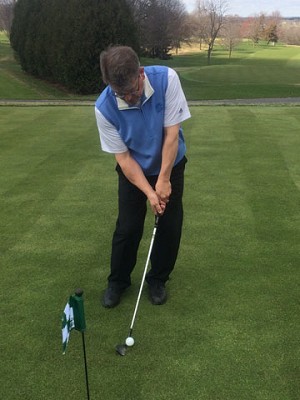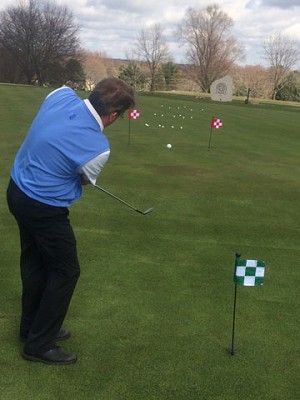Know Your Chip Shot Roll Out And Save Strokes with Solid Chipping
By Chuck Wood
First and foremost, the chip shot does not take physical prowess! The keys to executing consistent chip shots are solid technique, repetition of that technique in both block and random practice, and knowing your “roll out” distances. Your “roll out” is the distance the ball travels once it hits the ground. The question: How much of the total distance with the chip shot is air flight and how much is roll?
To calculate your roll out, place golf balls at a starting point (green flag in picture). Set a landing point at 8 paces (red flags) from starting point. To establish a roll out bench mark, hit the shots from a flat lie to a flat green surface. Using each one of your wedges, hit shots that that land at the 8 pace mark. Then take the average distance of how far the balls roll out for each wedge. In the pictured example, numerous shots were hit with three different wedges. Lowest lofted wedge rolled out 12 paces. Thus, the ball travelled 40% in the air and rolled out 60% of the total distance. The medium lofted wedge rolled out 8 paces (50% air and 50% roll). The highest lofted wedge rolled out 4 paces (67% in the air and 33% roll out). You now have a ratio that can be adjusted based on course conditions.
Golf course example: You have 15 paces to a flat front hole location. Knowing that your highest lofted wedge will fly 10 paces and roll out 5 paces (67% air and 33% roll), you pick a spot at 10 paces and try to land the ball at that point. The well-executed shot will hit near the spot, roll out 5 paces, and settle near the hole – if not in the hole! Please note you can use any combination of clubs- for instance, an 8 iron, pitching wedge, and a lob wedge combination would work.
The setup is an important element in chipping. Imagine the “Leaning Tower of Piza.” Your body angle should be similar to the tower with majority of your weight on your forward foot. Slight flex in the knees and bent at the waist (approximately 40 degrees) while letting your arms hang freely. The stroke is rhythmic yet crisp.
Practice methodology should include both “block” and “random” techniques. Block practice involves working on mechanics. Random practice simulates game conditions. “Two or Better”
is a great random practice challenge. From your starting point, hit a chip to the hole furthest
left on the practice green. Make the putt and you move to the next hole. Score higher than a two
repeat the hole. You are simulating game conditions!
Additional helpful thoughts:
Use the type of golf balls that you normally play.
Let the loft of the club do its job.
Swing the club – don’t scoop the club face to lift the ball.
Backswing will give you carry distance while follow through provides consistent roll out.
Keep it down the middle.































